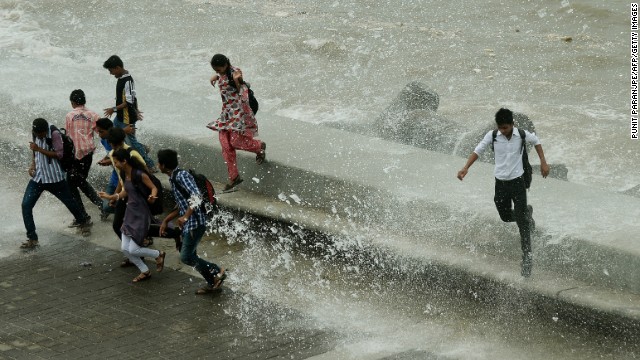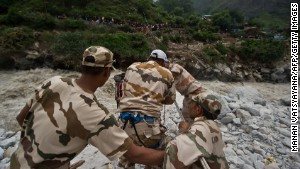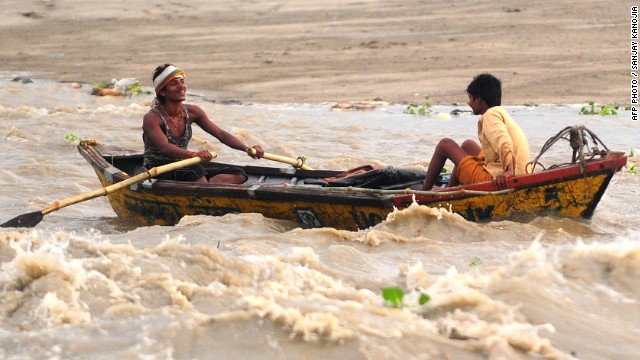Indian floods a man-made disaster, say environmentalists
June 25, 2013 -- Updated 2252 GMT (0652 HKT)
STORY HIGHLIGHTS
- Environmentalists blame rampant development for high death toll in Uttarakhand
- They blame hydro projects and ad hoc road building for exacerbating the problem
- Massive Hindu pilgrimages every year strain resources in the Himalayan state
- Uttarakhand is home to Rishikesh, the meditation retreat made famous by The Beatles
(CNN) -- As the source of the Ganges River, the site of Hinduism's famous Char Dham pilgrimage and home to Rishikesh, the meditation retreat made famous by The Beatles, the India's northern Uttarakhand state justifies its title of "Land of the Gods."
But environmentalists are warning that rampant development in the Himalayan state is tempting fate.
With roads built on an ad hoc basis, new hotel developments built on river banks and hydro dams proposed in the region's steep valleys, environmentalists say the floods and mudslides that have claimed more than 1,000 lives in the past week were an ecological catastrophe waiting to happen.
"You've heard of homicide, well this is ecocide," Devinder Sharma of the Forum for Biotechnology and Food Security told CNN. "The hills have been shorn of the forest cover, there's extensive mining taking place in this region and on top of that the roads that are being constructed are haphazard.
"And the hydro projects coming are phenomenal -- 70 hydro projects back to back. Obviously there are tunnels being built, hills being blasted and everything goes topsy-turvy.




"We are playing with nature but at the same time blaming nature."
He said while a massive national road-building program had been well received by India's state governments, routes had been planned through increasingly remote areas without adequate drainage, exacerbating the problems of coping with massive run-off from the region's monsoon rains.
A real estate boom in the region has also resulted in new developments going ahead without adequate planning permission.
"It's a classical model of disaster," he said. "If you want to see globally what can happen in regions like the Alps or the Rocky Mountains or elsewhere you only have to take a look at Uttarakhand."
Souparno Banerjee of the Indian advocacy group theCenter for Science and Environment said that despite state government denials, most experts were of the view that unregulated development and unregulated tourism is responsible for the scale of the disaster.
"Development is important but we need to keep in mind the very delicate eco-system that you're working within," he said. "The Himalayas are the biggest mountain range in the world but they are also extremely fragile.
"You need to keep that in mind when putting disaster management plans in place."
He said his organization recommended a certain amount of flow necessary to keep rivers in the region at a safe level, but that dam projects and river diversions for roads had backed up with flood waters from torrential rains.
"The drainage in many areas is half-baked," he told CNN.
Uttarakhand's chief minister Vijay Bahuguna told the Times of India newspaper that the floods had set back the state by at least three years in terms of development.
You've heard of homicide, well this is ecocide
Devinder Sharma
Devinder Sharma
"My people are going to suffer because tourism is going to be affected. We have to put the infrastructure back on the rails. I have written to the prime minister that preliminary reports suggest there is loss of Rs 3,000 crore (US$500 million). This tragedy has broken our economy," he said.
He said that a balance needed to be struck between the environment and development, adding that he did not want migration away from Uttarakhand.
"Seventy percent of my state is forest cover. (If) I am preserving my forests for the nation then why don't you give me compensation? Let the country compensate us."
He denied that the disaster was man-made and a result of the indiscriminate construction of hotels and houses.
"This is a very childish argument -- that cloudbursts, earthquakes and tsunamis are caused by human factors. In the history of hundreds of years of Kedarnath (a region of the state), no such incident has taken place. In a Himalayan state, this catastrophe has come about in 37,000 square miles of area. This cloudburst, 330 millimetres of rain, cannot be anticipated."


1 comment:
Anything which is done against nature can turn to be a disaster...current news in India
Post a Comment